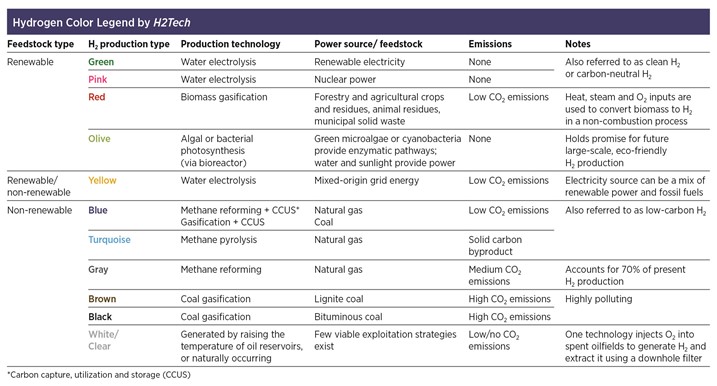News
Hydrogen color legend by H2Tech
H2Tech editorial coverage includes the entire "spectrum" of hydrogen production—encompassing different types, or "colors," of H2, as commonly referenced in industry jargon and further defined by the editorial team of H2Tech.
A summary of the commonly referenced colors of H2 follows, in order from renewable feedstock types to non-renewable types:
Green H2:
Produced via water electrolysis that is powered by renewable electricity, making the process carbon-neutral.
Pink H2:
Produced via water electrolysis that is powered by nuclear energy, making the process carbon-neutral.
Red H2:
Produced via biomass gasification, a process in which heat, steam and O2 inputs are used to convert biomass to H2 and other products in a controlled, non-combustion process. Feedstocks include forestry and agricultural crops and residues, animal residues, municipal solid waste and other biomasses. The process is associated with low CO2 emissions.
Olive H2:
Produced via algal or bacterial photosynthesis, via a bioreactor. Green microalgae or cyanobacteria provide enzymatic pathways, while water and sunlight provide power for the reaction. Although not a commercially viable technology pathway at this time, it holds promise for future large-scale, eco-friendly H2 production as a carbon-neutral process.
Yellow H2:
Produced via water electrolysis that is powered by mixed-origin grid energy (i.e., renewable energy and fossil fuels), associating it with low CO2 emissions.
Blue H2:
Produced via reforming of natural gas or gasification of coal, with added carbon capture, storage and utilization (CCUS). These processes are associated with low CO2 emissions when CCUS is employed.
Turquoise H2:
Produced via methane pyrolysis and grouped with low-carbon H2 production processes. Results in a solid carbon byproduct.
Gray H2:
Produced via reforming of natural gas (no CCUS). Accounts for 70% of present H2 production, and results in medium CO2 emissions.
Brown H2:
Produced via gasification of lignite coal. Results in high CO2 emissions, and is highly polluting.
Black H2:
via gasification of bituminous coal. Results in high CO2 emissions, and is highly polluting.
White/Clear H2:
Generated by raising the temperature of oil reservoirs, or naturally occurring in underground rocky deposits. Few viable H2 exploitation strategies exist, although one company injects O2 into spent oilfields to generate H2 and other gases and then extracts H2 via a wellbore, with the use of a proprietary downhole filter. The process is thought to be associated with low/no CO2 emissions.
A handy legend for the colors of H2 production also appears below for industry reference. For questions about these classifications, please email Editors@H2-Tech.com.


